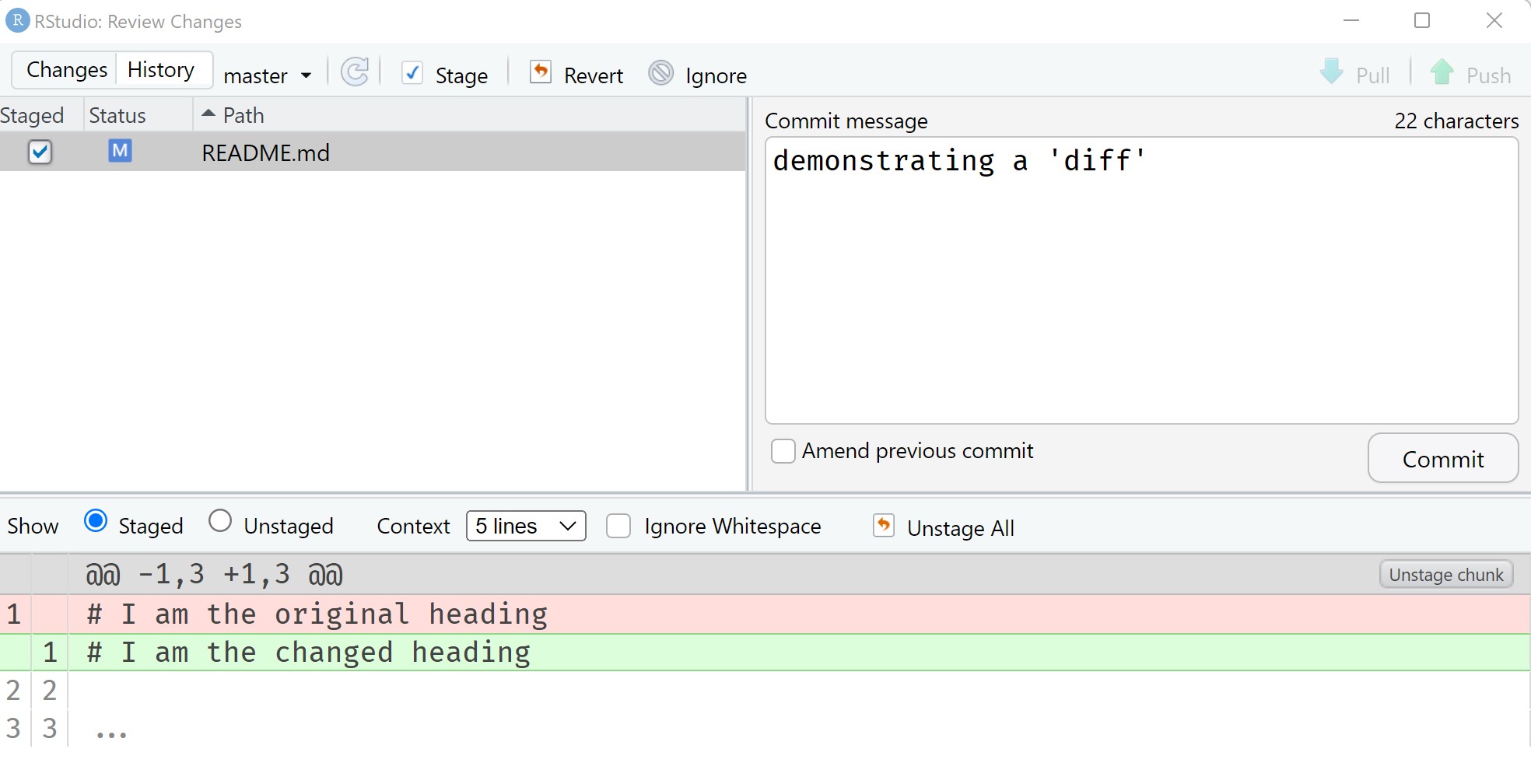flowchart LR A[<font size=4> Kevin v1] --> B[<font size=4> Kevin v2] B --> C[<font size=4> Kevin v3] B --> D[<font size=4> Daniel v1] D --> E[<font size=4> Kevin + Daniel v4] C --> E
5 Version Control & Collaboration
BBS Course: Good Software Engineering Practice for R Packages
Kevin
February 10, 2023
Disclaimer
Any opinions expressed in this presentation and on the following slides are solely those of the presenter and not necessarily those of their respective employer or company.
- Overview, demo, practical
- Can only scratch surface
- More resources on website
Photo by Rich @ rhubbardstockfootage on Unsplash
Trade-offs in code development
Working alone
- no coordination overhead
- no review
- lack of diversity
- can slack on documentation
- fragile long-term maintenance
Working in a team
- coordination overhead
- mutual review of code
- different approaches
- forced to document
- more robust long-term maintenance
Key issue:
Manage complexity over time or between people
Photo from Tim Mossholder on Unsplash
Version control systems (VCS)
- Manage different versions of a piece of work
- Compare and merge diverged versions effectively1
- Code is complex system \(\leadsto\) ideal application of VCS
- Compounded by multiple people ‘fiddling’ with it!
git basics
Enter git the ‘Latin of data science’

- Author Linus Torvalds, for work on Linux kernel
- Essentially a database with snapshots of a monitored ‘repository’ (directory)
- Optimized to compute line-based changes
- Integrated in RStudio IDE, Visual Studio Code
- De facto standard not just in the R world
- Alternatives: mercurial, SCM, …
Photo by Lf Asia & the Archive Team CC BY 3.0
Stage & commit

gitGraph commit commit commit commit commit
- ‘Stage’ changes for inspection
- allows to inspect propose changes before locking them in
- Permanently ‘commit’ changes to git
\(\leadsto\) Chain of versions with incremental changes
Photo by Felicia Montenegro on Unsplash
Line-based differences - the ‘diff’

- Changes in git are line-based
- Additions (green) & deletions (red) between commits
Going back in time

- Every commit has unique hash value
- Can ‘checkout’ old commit (browse history)
git checkout [commit hash to browse]- Can ‘reset’ changes
git reset --hard [commit hash to reset to]- Removes need for
my-file_final_v2_2019.R - Time travelling has its dangers…1
Photo by Mila Tovar on Unsplash
Branching

gitGraph commit commit branch feature checkout feature commit commit checkout main commit
- Variations of repository: ‘branches’
git checkout -b [my new branch]- Quick switching between branches
git checkout [branch name]Photo by Mila Tovar on Unsplash
‘Merging’ two branches

gitGraph commit commit branch feature checkout feature commit commit checkout main commit merge feature
- Consolidate diverged ‘branches’
- Usually merged automergically
- Conflicting changes
- Line edited in source/target branch - keep which?
- Resolving merge conflicts beyond today’s scope
Photo by Max LaRochelle on Unsplash
Example of ‘gitflow’
gitGraph commit tag: "v0.0.1" commit branch feature-1 checkout feature-1 commit commit checkout main branch feature-2 checkout feature-2 commit checkout feature-1 commit checkout main commit tag: "bugfix" merge feature-1 tag: "v0.1.0" checkout feature-2 commit
- ‘gitflow’: specific workflow for git repositories
- features developed on branches, then merged into ‘main’
Version Control & Collaboration
- git itself is command line tool for version control
- git platforms add UI for collaboration1
- GitHub.com de facto standard in R (alternative: GitLab.com)
- git + GitHub
- VCS (git)
- Web hosting of code (GitHub)
- Organisation with issues, discussions (GitHub)
- Automation of checks/test (GitHub)
git platforms
GitHub.com
- Huge number of R packages developed there:
- 100 million developers on GitHub.com (Jan ’23)
- 372 million repositories, 28 million public (Jan ’23)
- ‘Facebook’ of developers / social coding
- Discuss problems / propose changes
Branches & pull requests
- Branches are a git concept
- Git platforms add concept of ‘pull request’ (PR)1
- PR is ‘suggested merge’ from branch A to B
- Usually from ‘feature A’ to ‘main’
- Allow to preview problems before merge and discuss changes
- Once everyone is happy, a pull request2 can be merged
- Every PR has an associated branch, but not every branch has a PR
- More in the demo!
Automating things with GitHub
- GitHub provides
- cloud compute
- scripting framework (GitHub actions)
- Allows task automation, e.g.
- run unittests
- build & host documentation
- static code analysis (linting)
- Most important actions for R: github.com/r-lib/actions
- Extremely useful to enforce best-practices & quality
A typical GitHub workflow
sequenceDiagram
participant K as Kevin
participant GH as GitHub server
participant D as Daniel
K->>K: make change locally & commit to <feature>
K->>GH: push commit
K->>GH: open pull request
GH->>GH: run automated checks
K->>D: request review
D->>D: review code
D->>K: request changes
K->>K: implement changes locally & commit
K->>GH: push commit
GH->>GH: run automated checks
K->>D: request review
D->>D: review code
D->>GH: approve changes, unblocking merge
K->>GH: merge <feature> into <main>
GH->>GH: run automated checks on <main>
D->>GH: pull newest version of <main>
Looks awefully complicated, why?
- Efficient collaboration with novice/untrusted contributors
- Maintainer: automated checks reduce review burden
- Contributor: no need to check manually
- Branching promotes asynchronous work on features
- Full history - can always go back
\(\leadsto\) making code-collaboration scalable
Demo
- How does a pull request work?
- First steps for setting up the next practical
- Don’t panic - steps are all documented at
https://github.com/kkmann/simulatr
Practical - collaboration on GitHub
- Work in teams of ~3
- Go to https://github.com/kkmann/simulatr and read through the instructions in the README.md file
- The repository is a template to practice collaboration on GitHub
- Only one member per team needs to use the template and invite the others as collaborators!
- Take some time to checkout the
README.mdfile and set up your environment in posit cloud - Can you fix the errors with some pull requests?
- The purpose of this exercise is to explore the collaboration functionality of GitHub - not to produce a perfect package ;)
License information
- Creator (initial author): Kevin Kunzmann
- This work is licensed under the Creative Commons Attribution-ShareAlike 4.0 International License.
- The source files are hosted at github.com/kkmann/workshop-r-swe
- Important: To use this work you must provide the name of the creator (initial author), a link to the material, a link to the license, and indicate if changes were made